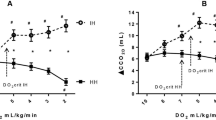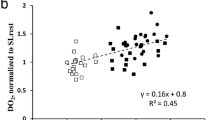Abstract
A major displacement of the blood O2 dissociation curve (ODC) was achieved in rats by chronic administration of sodium cyanate (NaOCN). Control animals with a normal position of the ODC received NaCl instead. Arterial and mixed-venous O2 content (\({\text{C}}_{{\text{O}}_{\text{2}} }\)) and O2 consumption were measured during breathing room air, 14.9, 8.0, or 5.6% O2 in N2. Cardiac output was obtained by the Fick principle.86RbCl was administered i.v., the rats were killed and the activity of86Rb in heart, spleen, stomach and intestines, liver, kidney, skeletal muscle, and skin was measured. According to Sapirstein (1956, 1958) the fractional uptake of86Rb in these organs corresponds to the fractions of cardiac output supplying these organs, and from the fractional uptake and cardiac output the nutritional blood flow may be calculated.
Arterial and mixed-venous\({\text{C}}_{{\text{O}}_{\text{2}} }\) was larger in the NaOCN than in the NaCl rats at all levels of oxygenation. At normoxia and 14.9% O2 the venous\({\text{C}}_{{\text{O}}_{\text{2}} }\) was enlarged more than the arterial one, and so the arterio-venous O2 difference [\(\left( {{\text{a}} - {\text{v}}} \right)_{{\text{O}}_{\text{2}} }\)] as an index of the O2 extraction in the body was smaller in the rats with a left-shifted ODC. However, at more severe hypoxia (8.0 and 5.6% O2) the arterial\({\text{C}}_{{\text{O}}_{\text{2}} }\) in the NaOCN rats was enlarged more than the mixed-venous one, resulting in a larger\(\left( {{\text{a}} - {\text{v}}} \right)_{{\text{O}}_{\text{2}} }\) (and therefore O2 extraction) when compared with the NaCl animals. Cardiac output was larger in the NaOCN than in the NaCl rats at 14.9 and 5.6% O2, when expressed per kg body weight. At 14.9% O2 the augmented cardiac output compensated for the lower O2 extraction when compared with the NaCl animals. At 5.6% O2 the NaOCN rats had both a larger (\(\left( {{\text{a}} - {\text{v}}} \right)_{{\text{O}}_{\text{2}} }\)) and cardiac output than the NaCl animals. In the NaCl rats the decreased O2 extraction was not compensated for by an augmented cardiac output and therefore their O2 consumption was not only lower than that of the NaOCN rats but decreased even below the normoxic value of the NaCl rats.
Coronary blood flow was increased in both NaOCN and NaCl animals at deep hypoxia to about the same extent, but due to a much lower arterial\({\text{C}}_{{\text{O}}_{\text{2}} }\) of the NaCl animals, their O2 supply to the heart was lower than that of the NaOCN rats. The nutritional blood flow to spleen, kidney, liver, stomach and intestines, and skin in ml/min · g was lower in the rats with a normal position of the ODC than in those with a left-shifted ODC. This, together with the low arterial\({\text{C}}_{{\text{O}}_{\text{2}} }\) of the NaCl rats, suggests a serious compromising of the O2 supply to these organs.
Results of this study support the conclusion of our theoretical studies (Turek et al., 1973; Turek and Kreuzer, 1976) that a shift of the ODC to the left might be disadvantageous for the O2 transport to tissues at mild hypoxia, but advantageous at severe hypoxia.
Similar content being viewed by others
References
Allison, T. B., Pieper, G. M., Clayton, F. C., Eliot, R. S.: Reduced high-energy phosphate levels in rat hearts. II. Effects of sodium cyanate. Am. J. Physiol.230, 1751–1754 (1976)
Aste-Salazar, H., Hurtado, A.: The affinity of hemoglobin for oxygen at sea level and at high altitude. Am. J. Physiol.142, 733–743 (1944)
Bakker, J. C.: 2,3-Disphosphoglycerate, Haemoglobin and O2 Release to Tissues. Thesis, University of Amsterdam, Meppel: Krips Repro B.V. 1977
Bakker, J. C., Gortmaker, G. C., Vrolijk, A. C. M., Offerijns, F. J. G.: The influence of the position of the oxygen dissociation curve on oxygen-dependent functions of the isolated perfused rat liver. I. Studies at different levels of hypoxic hypoxia. Pflügers Arch.362, 21–31 (1976)
Duvelleroy, M. A., Mehmel, H., Laver, M. B.: Hemoglobin-oxygen equilibrium and coronary blood flow: an analog model. J. Appl. Physiol.35, 480–484 (1973)
Eaton, J. W., Skelton, T. D., Berger, E.: Survival at extreme altitude: protective effect of increased hemoglobin-oxygen affinity. Science183, 743–744 (1974)
Fulton, R. M., Hutchinson, E. C., Jones, A. M.: Ventricular weight in cardiac hypertrophy. Br. Heart J.14, 413–420 (1952)
Lenfant, C., Torrance, J., English, E., Finch, C. A., Reynafarje, C., Ramos, J., Faura, J.: Effect of altitude on oxygen binding by hemoglobin and on organic phosphate levels. J. Clin. Invest.47, 2652–2656 (1968)
Mehmel, H. C., Duvelleroy, M. A., Laver, M. B.: Response of coronary blood flow to pH-induced changes in hemoglobin-O2 affinity. J. Appl. Physiol.35, 485–489 (1973)
Monge, C. C., Whittembury, J.: Increased hemoglobin-oxygen affinity at extremely high altitudes. Science186, 843 (1974)
Penncy, D., Thomas, M.: Hematological alterations and response to acute hypobaric stress. J. Appl. Physiol.39, 1034–1037 (1975)
Rakušan, K., Rajhathy, J.: Distribution of cardiac output and organ blood content in anemic and polycythemic rats. Can. J. Physiol. Pharmacol.50, 703–710 (1972)
Roughton, F. J. W., Scholander, P. F.: Micro gasometric estimation of the blood gases. I. Oxygen. J. Biol. Chem.148, 541–550 (1943)
Sapirstein, L. A.: Fractionation of the cardiac output of rats with isotopic potassium. Circ. Res.9, 689–692 (1956)
Sapirstein, L. A.: Regional blood flow by fractional distribution of indicators. Am. J. Physiol.193, 161–168 (1958)
Snedecor, G. W., Cochran, W. G.: Statistical Methods. Ames, Iowa: Iowa University Press 1967
Takács, L., Kállay, K., Vajda, V.: The effect of acute arterial hypoxia on the organ blood flow in rats. Acta Physiol. Acad. Sci. Hung.21, 87–91 (1962)
Turek, Z., Kreuzer, F.: Effect of a shift of the oxygen dissociation curve on myocardial oxygenation at hypoxia. In: Oxygen Transport to Tissue—II. Advances in Experimental Medicine and Biology, Vol. 75 (J. Grote, D. Reneau and G. Thews, Eds.), pp. 657–662. New York and London: Plenum Press 1976
Turek, Z., Frans, A., Kreuzer, F.: Steady-state diffusing capacity for carbon monoxide in the rat. Respir. Physiol.12, 346–360 (1971)
Turek, Z., Kreuzer, F., Hoofd, L. J. C.: Advantage or disadvantage of a decrease of blood oxygen affinity for tissue oxygen supply at hypoxia. A theoretical study comparing man and rat. Pflügers Arch.342, 185–197 (1973)
Turek, Z., Kreuzer, F., Ringnalda, B. E. M.: Blood gases at several levels of oxygenation in rats with a left-shifted blood oxygen dissociation curve. Pflügers Arch.376, 7–13 (1978)
Weber, E.: Grundriß der Biologischen Statistik. Jena: VEB Gustav Fischer 1961
Woodson, R. D.: Effect of increased oxygen affinity on cardiac output and its distribution. XXVIIth International Congress of Physiological Sciences, Paris 1977. Proceedings of the International Union of Physiological Sciences, Vol. XIII, Abstract of Volunteer Papers, p. 820
Author information
Authors and Affiliations
Rights and permissions
About this article
Cite this article
Turek, Z., Kreuzer, F., Turek-Maischeider, M. et al. Blood O2 content, cardiac output, and flow to organs at several levels of oxygenation in rats with a left-shifted blood oxygen dissociation curve. Pflugers Arch. 376, 201–207 (1978). https://doi.org/10.1007/BF00584951
Received:
Issue Date:
DOI: https://doi.org/10.1007/BF00584951




